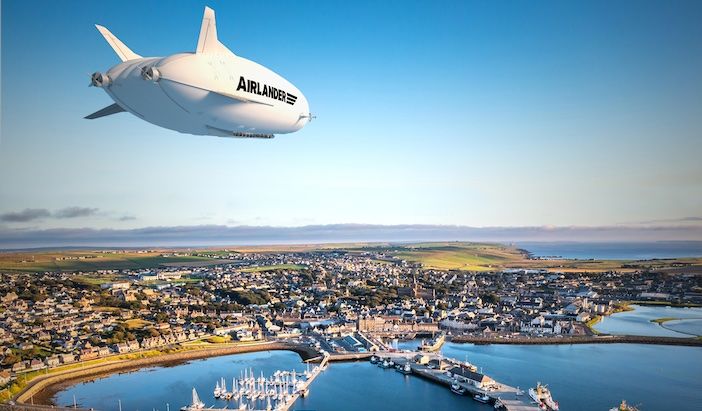The US Navy is working with UK-based Hybrid Air Vehicles to assess the potential use of the Airlander airship as a logistics platform.
A research program is being funded by the US Department Of Defense’s Operational Energy Office to simulate and analyze the use of an Airlander hybrid airship in the US Indo-Pacific Command (INDOPACOM).
The move represents a return to the US military for the Airlander, which started life in 2007 as an aerial platform for battlefield observation for the US Air Force, before the program was scrapped in 2014. Hybrid Air Vehicles bought the prototype and has continued to develop and test the concept for commercial applications since 2016.
The Airlander 10 will carry up to 100 passengers, have a range of 4,600 miles (7,400km), a top speed of around 85mph (km/h), and will be able to stay airborne for up to five days. HAV plans to begin regional passenger-carrying services with the airship in 2026.
The company has also recently set out plans to develop the Airlander 50, a larger version for freight applications which will enter service by 2030
Marine Corps Captains Ben Cohen, the lead for the US Navy research program said, “As a logistics officer, the challenges with contested logistics are at the forefront of my mind.
“After attending a highly productive working group with the INDOPACOM Logistics, Plans, and Exercises Division in November of 2022, we designed this research effort to be able to respond to many of the challenges identified by the cross-functional team.
“When we reach the second phase, we will be ready to support modeling, simulation, and analysis of the hybrid aircraft in use cases that are defined by any combatant commander, but with a particular eye to contested logistics challenges in INDOPACOM.”
Ben Cohen and Marine Corps Captain John Schmaltz became interested in the defense applications of hybrid aircraft like Airlander while students at the Naval Postgraduate School (NPS) and were introduced to HAV through the NPS alumni network.
Their thesis which assesses commercially developed, large-capacity transportation platforms, has been instrumental in the current work with HAV.
This latest project leverages commercial innovation to adopt and adapt commercial sustainable aviation technology, change operational concepts, and address logistical capability gaps.
The lack of existing infrastructure within INDOPACOM limits current asset flexibility for inter/intra-theater lift, where access to deep water ports and airfields to accommodate appropriate aircraft is limited.
With no need for ports or runways, Airlander aircraft can land on any reasonably flat surface, providing much-needed mobility resilience and flexibility in support of distributed maritime operations and expeditionary warfighting.
Tom Grundy, CEO of Hybrid Air Vehicles said, “Our Airlander hybrid aircraft represents a game-changing technology for ultra-low-emissions flight, that can also revolutionize the capabilities of the Department of Defense.
“Through our collaboration with Capt. Ben Cohen and through the R&D work with the Naval Postgraduate School, we are demonstrating how private investment and commercial innovation can be adapted to enhance logistics, intelligence, surveillance, and reconnaissance operations, and communications in the Pacific.
“The Zero Carbon Logistics Support Via Hybrid Aircraft project has the potential to transform the way the U.S. Navy and Marine Corps conduct operations in contested and distributed environments, providing them with an unparalleled advantage in the region.”
The latest project builds on an existing three-year Cooperative R&D Agreement (CRADA) that has been running since August 2021 between HAV and NPS. As part of the CRADA Cohen and Schmaltz have been exploring the potential of civilian hybrid aircraft technologies and evaluating how to adapt Airlander for US Marine Corps-led scenarios in logistics and mobility applications.
Cohen and Schmaltz’s research emphasized the importance of digital technology, particularly digital twins, and expanded the opportunities for DOD applications of hybrid aircraft technology.
NPS’ Modeling Virtual Environments and Simulation (MOVES) Institute analyzed the Airlander 10’s potential for surface surveillance missions in the Arctic Ocean resulting in the development of a virtual reality view of defense-unique missions using hybrid aircraft.
The MOVES Institute is continuing this research, using the Airlander 10 concept for EABO and Littoral Operations in a Contested Environment (LOCE) modeling, which is crucial for ideating new concepts and examining how new technologies integrate with existing infrastructure. The MOVES Institute is planning to model other environments for HAV to showcase hybrid aircraft capabilities in both the civilian and defense sectors.





